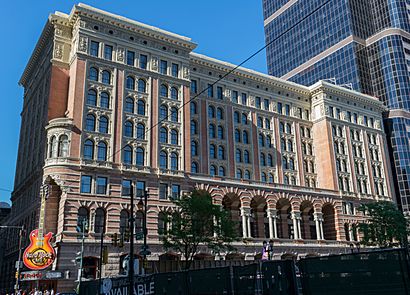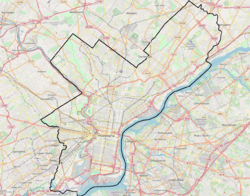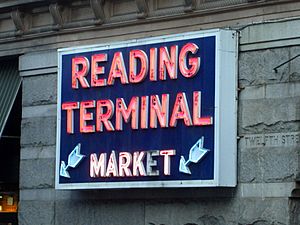Reading Terminal facts for kids
Quick facts for kids
Reading Terminal
|
|||||||||||||||||||||||||||||||||||||||||||||||||||||||||
|---|---|---|---|---|---|---|---|---|---|---|---|---|---|---|---|---|---|---|---|---|---|---|---|---|---|---|---|---|---|---|---|---|---|---|---|---|---|---|---|---|---|---|---|---|---|---|---|---|---|---|---|---|---|---|---|---|---|
| Former SEPTA regional rail station | |||||||||||||||||||||||||||||||||||||||||||||||||||||||||
 |
|||||||||||||||||||||||||||||||||||||||||||||||||||||||||
| Location | 1115-1141 Market Street, Philadelphia, PA 19107 | ||||||||||||||||||||||||||||||||||||||||||||||||||||||||
| Connections | SEPTA at Jefferson Station and 11th Street | ||||||||||||||||||||||||||||||||||||||||||||||||||||||||
| Construction | |||||||||||||||||||||||||||||||||||||||||||||||||||||||||
| Disabled access | No | ||||||||||||||||||||||||||||||||||||||||||||||||||||||||
| History | |||||||||||||||||||||||||||||||||||||||||||||||||||||||||
| Opened | January 29, 1893 | ||||||||||||||||||||||||||||||||||||||||||||||||||||||||
| Closed | November 6, 1984 | ||||||||||||||||||||||||||||||||||||||||||||||||||||||||
| Electrified | Yes | ||||||||||||||||||||||||||||||||||||||||||||||||||||||||
|
|||||||||||||||||||||||||||||||||||||||||||||||||||||||||
|
Reading Terminal and Trainshed
|
|||||||||||||||||||||||||||||||||||||||||||||||||||||||||
| Location | 1115–1141 Market St., Philadelphia, Pennsylvania | ||||||||||||||||||||||||||||||||||||||||||||||||||||||||
| Built | 1891–93 | ||||||||||||||||||||||||||||||||||||||||||||||||||||||||
| Architect | Wilson Brothers & Company (train shed) Francis H. Kimball (headhouse) |
||||||||||||||||||||||||||||||||||||||||||||||||||||||||
| NRHP reference No. | 72001170 | ||||||||||||||||||||||||||||||||||||||||||||||||||||||||
| Significant dates | |||||||||||||||||||||||||||||||||||||||||||||||||||||||||
| Added to NRHP | June 30, 1972 | ||||||||||||||||||||||||||||||||||||||||||||||||||||||||
| Designated NHL | December 8, 1976 | ||||||||||||||||||||||||||||||||||||||||||||||||||||||||
The Reading Terminal (RED-ing) is a group of buildings in Philadelphia, Pennsylvania. It used to be the main train station for the Reading Company. The terminal is in the Market East area of Center City. It includes the Reading Terminal Headhouse (the main building), the Trainshed (where trains were kept), and the Reading Terminal Market (a food market).
Contents
History of Reading Terminal
Building the Station
In 1889, the Philadelphia and Reading Railway decided to build a new train station. They wanted a place for trains, passengers, and their company offices. This new station would be at 12th and Market Streets. Other big railroads, like the Pennsylvania Railroad and the Baltimore and Ohio Railroad, already had their own stations nearby.
The spot chosen for the Reading Terminal was home to an outdoor market. This market had been open since 1853. People who ran the market were upset about moving. After many complaints and talks, the railroad agreed to buy the market for $1 million. They also promised to build a new home for the market. This new place, the Reading Terminal Market, was built behind the main station building.
Because of the market below, the train shed and all its tracks had to be built one floor above street level. The Ninth Street Branch train line was used to bring trains in and out.
Building Design
The main building (headhouse) was designed in 1891 by Francis H. Kimball. The train shed was designed by Wilson Brothers & Company. Construction started in the same year. The station opened on January 29, 1893.
At that time, the train shed was one of the biggest buildings in the world with one huge arched roof. The Reading's train shed is now the only one of its kind left in the United States.
The main building on Market Street was eight stories tall. It held the passenger station and the company's offices. It was built in the Italian Renaissance style. It had strong brick walls, iron pillars, and wooden floors. Inside, there were fancy plaster designs, marble, and iron decorations.
Reading Terminal Station in Use
Reading Terminal served trains that went between cities and to nearby towns. Many of these train lines are still running today as part of the SEPTA Regional Rail system. This system connects Center City with neighborhoods and suburbs, especially to the north.
Many trains were switched to electric power between 1928 and 1933. During World War II, the station was very busy. Up to 45,000 passengers used it every day. But in the 1950s, fewer people took trains as more started using cars and airplanes.
Some major trains that left from Reading Terminal in the mid-1900s included:
- Black Diamond - went to Buffalo
- Crusader - went to Jersey City
- Maple Leaf - went to Toronto
The station buildings started to show their age as the railroad faced money problems. The Reading Company went bankrupt in 1971. The train shed was added to the National Register of Historic Places in 1972. It was named a National Historic Landmark in 1976.
In 1976, Conrail took over the freight trains of the Reading and other lines. SEPTA, Philadelphia's local transit group, took over the passenger train service. SEPTA also got control of the old PRR train lines. They decided to connect all the regional train services.
SEPTA started building the Center City Commuter Connection. This was an underground train tunnel. It would connect the old Reading train lines with the old Pennsylvania Railroad lines. The new Market East Station was built to replace Reading Terminal. This new station is next to and partly under the old Reading Terminal.
Reading Terminal's last train left on November 6, 1984. A few days later, train service from the old Reading lines moved to the new Market East Station.
What Happened Next
After the station closed, people wondered what would happen to Reading Terminal. Some wanted to tear it down. But a group led by Edmund Bacon saved it. They pointed out its special landmark status.
In 1993, the Reading Terminal was chosen to be the new Pennsylvania Convention Center. The city bought the complex. After changes were finished in 1997, the main building became the convention center's entrance. The train shed became its Grand Hall and ballroom.
The building now has shops and food places on its lower levels. The old Reading Railroad offices on the upper floors were turned into meeting rooms and ballrooms. It also has over 200 rooms for the nearby Marriott Hotel. The hotel is connected to the terminal by a skywalk.
The Reading Terminal Market became its own separate business. A special group was formed in 1994 to manage the market.
In Film
Several movies have filmed scenes at the terminal. These include:
- The 1981 film Blow Out
- The 1995 film Twelve Monkeys
- The 2004 film National Treasure
Gallery
-
Reading Terminal Market, SE corner 12th & Arch Sts., under the Trainshed
-
Pennsylvania Convention Center Grand Hall, 1993 occupies the former train shed.












